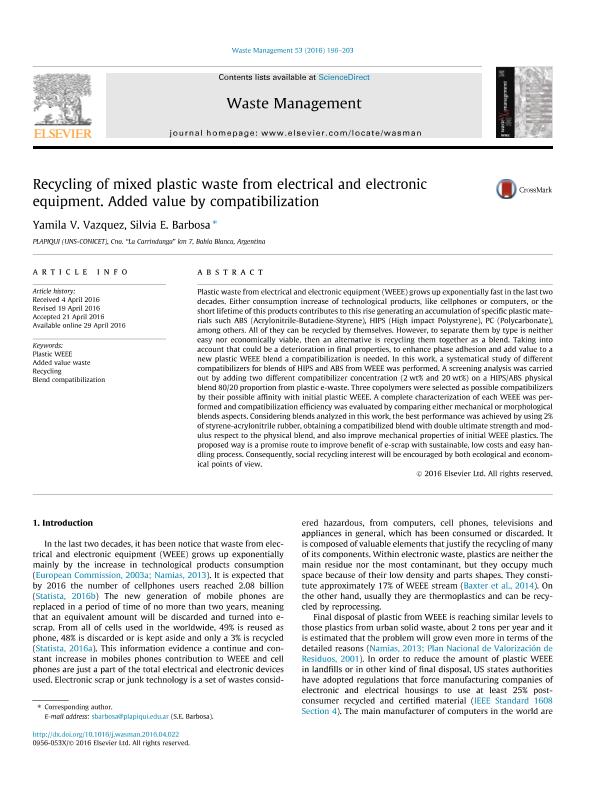Mostrar el registro sencillo del ítem
dc.contributor.author
Vazquez, Yamila Victoria

dc.contributor.author
Barbosa, Silvia Elena

dc.date.available
2017-10-19T15:07:23Z
dc.date.issued
2016-04-29
dc.identifier.citation
Vazquez, Yamila Victoria; Barbosa, Silvia Elena; Recycling of mixed plastic waste from electrical and electronic equipment: added value by compatibilization; Elsevier; Waste Management (elmsford); 53; 29-4-2016; 196-203
dc.identifier.issn
0956-053X
dc.identifier.uri
http://hdl.handle.net/11336/26801
dc.description.abstract
Plastic waste from electrical and electronic equipment (WEEE) grows up exponentially fast in the last two decades. Either consumption increase of technological products, like cellphones or computers, or the short lifetime of this products contributes to this rise generating an accumulation of specific plastic materials such ABS (Acrylonitrile-Butadiene-Styrene), HIPS (High impact Polystyrene), PC (Polycarbonate), among others. All of they can be recycled by themselves. However, to separate them by type is neither easy nor economically viable, then an alternative is recycling them together as a blend. Taking into account that could be a deterioration in final properties, to enhance phase adhesion and add value to a new plastic WEEE blend a compatibilization is needed. In this work, a systematical study of different compatibilizers for blends of HIPS and ABS from WEEE was performed. A screening analysis was carried out by adding two different compatibilizer concentration (2 wt% and 20 wt%) on a HIPS/ABS physical blend 80/20 proportion from plastic e-waste. Three copolymers were selected as possible compatibilizers by their possible affinity with initial plastic WEEE. A complete characterization of each WEEE was performed and compatibilization efficiency was evaluated by comparing either mechanical or morphological blends aspects. Considering blends analyzed in this work, the best performance was achieved by using 2% of styrene-acrylonitrile rubber, obtaining a compatibilized blend with double ultimate strength and modulus respect to the physical blend, and also improve mechanical properties of initial WEEE plastics. The proposed way is a promise route to improve benefit of e-scrap with sustainable, low costs and easy handling process. Consequently, social recycling interest will be encouraged by both ecological and economical points of view.
dc.format
application/pdf
dc.language.iso
eng
dc.publisher
Elsevier

dc.rights
info:eu-repo/semantics/openAccess
dc.rights.uri
https://creativecommons.org/licenses/by-nc-nd/2.5/ar/
dc.subject
Plastic Weee
dc.subject
Added Value Waste
dc.subject
Recycling
dc.subject
Blend Compatibilization
dc.subject.classification
Otras Ingeniería Química

dc.subject.classification
Ingeniería Química

dc.subject.classification
INGENIERÍAS Y TECNOLOGÍAS

dc.title
Recycling of mixed plastic waste from electrical and electronic equipment: added value by compatibilization
dc.type
info:eu-repo/semantics/article
dc.type
info:ar-repo/semantics/artículo
dc.type
info:eu-repo/semantics/publishedVersion
dc.date.updated
2017-10-09T15:33:25Z
dc.journal.volume
53
dc.journal.pagination
196-203
dc.journal.pais
Países Bajos

dc.journal.ciudad
Amsterdam
dc.description.fil
Fil: Vazquez, Yamila Victoria. Consejo Nacional de Investigaciones Científicas y Técnicas. Centro Científico Tecnológico Conicet - Bahía Blanca. Planta Piloto de Ingeniería Química. Universidad Nacional del Sur. Planta Piloto de Ingeniería Química; Argentina
dc.description.fil
Fil: Barbosa, Silvia Elena. Consejo Nacional de Investigaciones Científicas y Técnicas. Centro Científico Tecnológico Conicet - Bahía Blanca. Planta Piloto de Ingeniería Química. Universidad Nacional del Sur. Planta Piloto de Ingeniería Química; Argentina
dc.journal.title
Waste Management (elmsford)

dc.relation.alternativeid
info:eu-repo/semantics/altIdentifier/url/http://www.sciencedirect.com/science/article/pii/S0956053X16301854
dc.relation.alternativeid
info:eu-repo/semantics/altIdentifier/doi/http://dx.doi.org/10.1016/j.wasman.2016.04.022
Archivos asociados
